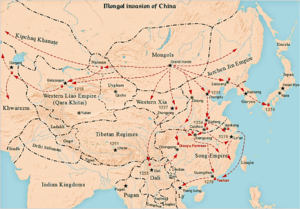Mongol invasions and conquests facts for kids
Quick facts for kids Mongol invasions and conquests |
|||||
|---|---|---|---|---|---|
 Expansion of the Mongol Empire 1206–94 |
|||||
|
|||||
| Casualties and losses | |||||
| Total dead: 20–57 million | |||||
The Mongol invasions and conquests were a series of military campaigns that happened in the 13th and 14th centuries. These campaigns led to the creation of the Mongol Empire, which was the largest empire in history that was all connected by land. By 1260, this huge empire covered large parts of Eurasia (the combined continents of Europe and Asia). Many historians believe the destruction caused by the Mongols was one of the deadliest times in history.
Contents
How the Mongol Empire Grew
The Mongol Empire grew very quickly in the 13th century through many successful military campaigns across Eurasia. At its biggest, it stretched from the Pacific Ocean in the east all the way to Central Europe in the west.
Unlike later "empires of the sea" (like European colonial powers that used ships), the Mongol Empire was a "land power." This means it relied on its strong cavalry (soldiers on horseback) and their horses, which needed lots of grass to eat. Because of this, most Mongol conquests and raids happened during warmer seasons. This was when there was enough grass for their large herds of horses. The Mongols' rise was also helped by 15 years of wet and warm weather from 1211 to 1225. This weather was perfect for breeding many horses, which helped them expand even more.
After 1260, the Mongol Empire started to break apart into smaller parts. But even then, conflicts between Mongol groups and Eastern European countries continued for many centuries. Mongols ruled China under the Yuan dynasty until the 14th century. In Persia, Mongol rule continued into the 15th century under the Timurid Empire. Later, in India, the Mughal Empire, which had Mongol roots, lasted until the 19th century.
Major Conquests and Their Results
Central Asia
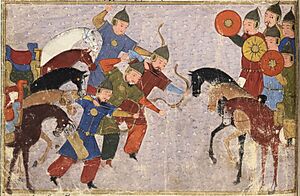
Genghis Khan was the leader who first brought together the various nomadic tribes of Central Asia. These included the Merkits, Tatars, Keraites, Turks, Naimans, and Mongols. The Buddhist Uighurs of Qocho gave up peacefully and joined the empire. Genghis Khan then continued to expand his empire by conquering the Qara Khitai and the Khwarazmian Empire.
Many cities and towns in Islamic Central Asia and northeastern Persia were greatly damaged. If a city resisted the Mongols, it was often destroyed. Many people died during these conquests. For example, after the city of Urgench was taken, a very large number of people were killed.
The Mongols used clever tactics against groups like the Alans and the Cumans (Kipchaks). They first told the Cumans to stop helping the Alans. After defeating the Alans, they then attacked the Cumans. Some Alans later joined the Mongol army. Mongols and Chinese soldiers also set up a military colony in the area of Qocho.
During the Mongol attacks on the Middle East, the Mamluk Sultanate (a Muslim empire) fought back. Many of the Mamluk soldiers were Kipchaks. The Golden Horde (a Mongol group) supplied more Kipchak fighters to the Mamluk armies, which helped them fight off the Mongols. Some Cumans fled to Hungary to escape the Mongols.
After the Mongol conquest, the Kipchaks, who did not have a central government, became Muslims. The Mongol conquest of the Kipchaks led to a new society. The Mongols were the rulers, but the people mostly spoke Kipchak. This group later became known as Tatars.
West Asia
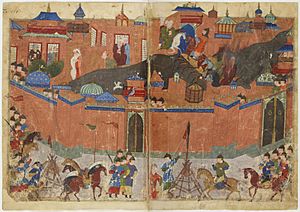
The Mongols conquered or gained control of areas that are now Iran, Iraq, the Caucasus region, and parts of Syria and Turkey. Mongol raids also reached south into Palestine, as far as Gaza, in 1260 and 1300.
Two very important events were the siege of Baghdad in 1258 and the Battle of Ain Jalut in 1260. In Baghdad, the Mongols destroyed the city, which had been a major center of Islamic power for 500 years. At the Battle of Ain Jalut in southern Galilee, the Muslim Bahri Mamluks managed to defeat the Mongols. This was a very important victory because it stopped the Mongol advance for the first time. Chinese engineers also helped the Mongol army during their conquest of the Middle East.
East Asia

Genghis Khan and his family launched many invasions into China. They first took over the Western Xia in 1209 and then completely destroyed them in 1227. They defeated the Jin dynasty in 1234 and finally conquered the Song dynasty in 1279.
The Mongols also made the Kingdom of Dali a vassal state (a state that is controlled by a more powerful one) in 1253. The King of Dali, Duan Xingzhi, even helped the Mongols conquer the rest of Yunnan. The Mongols forced Korea to surrender after nine invasions. However, they failed in their attempts to invade Japan. Their fleets were destroyed by powerful storms called kamikaze (which means "divine wind").
The Mongols' biggest success in East Asia was when Kublai Khan (Genghis Khan's grandson) established the Yuan dynasty in China in 1271. This dynasty created new armies, including a "Han Army" made of soldiers who had left the Jin dynasty, and a "Newly Submitted Army" made of soldiers who had left the Song dynasty.
The Mongol army that invaded southern China was much larger than the one sent to the Middle East in 1256. The Yuan dynasty also set up a special government office to rule Tibet, which the Mongols had conquered. The Mongols also invaded Sakhalin Island between 1264 and 1308. Korea (Goryeo) also became a semi-independent vassal state of the Yuan dynasty for about 80 years.
North Asia
By 1206, Genghis Khan had conquered all the Mongol and Turkic tribes in Mongolia and southern Siberia. In 1207, his oldest son, Jochi, brought many Siberian forest people under Mongol rule. These included the Uriankhai, Oirats, Barga, Khakas, Buryats, Tuvans, Khori-Tumed, and Yenisei Kyrgyz. He organized these Siberians into military units. Genghis Khan also gave control of some areas to his trusted companions.
After the first part of the Mongol conquest of the Jin dynasty, Genghis Khan created a settlement of Chinese craftspeople and farmers in Kem-kemchik. The Mongol leaders, known as Great Khans, valued things like gyrfalcons (a type of bird), furs, and Kyrgyz horses as tribute (payments) from these regions.
Western Siberia came under the control of the Golden Horde, a part of the Mongol Empire. The descendants of Orda Khan, Jochi's eldest son, directly ruled this area. In the swampy parts of western Siberia, dog sled stations were set up to help collect tribute.
Later, in 1270, Kublai Khan sent a Chinese official to act as a judge in the Kyrgyz and Tuvan areas. A grandson of Ogedei, named Kaidu, took over parts of Central Siberia from 1275 onwards. However, the Yuan dynasty army, led by Kublai's general Tutugh, took back the Kyrgyz lands in 1293. From then on, the Yuan dynasty controlled large parts of Central and Eastern Siberia.
Eastern and Central Europe
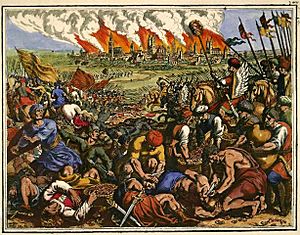
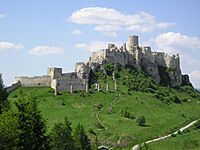
The Mongols invaded and destroyed Volga Bulgaria and Kievan Rus' (an early Russian state). Then, they went on to invade Poland, Hungary, Bulgaria, and other areas. Over three years (1237–1240), the Mongols destroyed almost all the major cities in Russia, except for Novgorod and Pskov.
Giovanni da Pian del Carpine, who was the Pope's representative to the Mongol Great Khan, traveled through Kiev in 1246. He wrote about the devastation:
The Mongols attacked Russia, causing great destruction. They destroyed cities and fortresses and killed many people. They attacked Kiev, the capital of Russia, for a long time, then took it and killed its people. When we traveled through that land, we saw countless bones of dead people lying on the ground. Kiev had been a very large city with many people, but now it is almost nothing. There are hardly two hundred houses there now, and the people are kept as slaves.
The Mongol invasions caused huge numbers of people to move from their homes in Central Asia and Eastern Europe. News of the approaching Mongol armies caused widespread fear and panic. The violent nature of these invasions also led to more conflicts among the leaders in Europe.
South Asia
From 1221 to 1327, the Mongol Empire launched several invasions into the Indian subcontinent. The Mongols controlled parts of northwestern South Asia for many decades. However, they were not able to get past the areas around Delhi and were pushed back from the inner parts of India. Centuries later, the Mughals, whose founder Babur had Mongol family roots, established their own empire in India.
Southeast Asia
Kublai Khan's Yuan dynasty invaded Burma between 1277 and 1287. This led to the surrender and breakup of the Pagan Kingdom. However, the invasion of 1301 was successfully fought off by the Burmese Myinsaing Kingdom. The Mongol invasions of Vietnam (Đại Việt) and Java ended in defeat for the Mongols. Even so, many parts of Southeast Asia agreed to pay tribute to the Mongols to avoid more fighting.
The Mongol invasions also played an indirect role in the creation of major Tai states in the region. These states were formed by Tai people who had recently moved from Southern China. Major Tai states like Lan Na, Sukhothai, and Lan Xang appeared around this time.
How Many People Died?
It is hard to know exactly how many people died during the Mongol conquests because there are not many records from that time. Estimates of the deaths vary a lot. Not counting the deaths from the Plague in Europe, West Asia, or China, it is thought that between 20 and 57 million people might have died between 1206 and 1405. These deaths happened during the many campaigns led by Genghis Khan, Kublai Khan, and Timur. The violence included battles, sieges (surrounding cities), early forms of biological warfare, and mass killings.
Images for kids
See also
- Destruction under the Mongol Empire
- Slave trade in the Mongol Empire
- Division of the Mongol Empire
- Lists of battles of the Mongol invasion of Europe
- List of battles of the Mongol invasion of Kievan Rus'
- Mongol invasion of Europe
- Mongol military tactics and organization
- Political divisions and vassals of the Mongol Empire
- Timeline of the Mongol Empire
- Timeline of the Golden Horde


